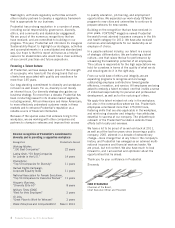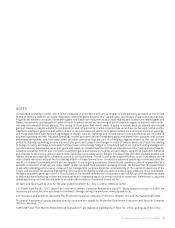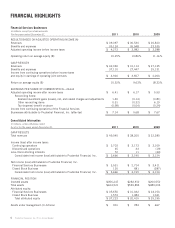Prudential 2011 Annual Report Download - page 15
Download and view the complete annual report
Please find page 15 of the 2011 Prudential annual report below. You can navigate through the pages in the report by either clicking on the pages listed below, or by using the keyword search tool below to find specific information within the annual report.been affected by adverse global market conditions, and uncertainty continues to be a factor in the market environment. This uncertainty,
particularly in the equity markets, has led to, among other things, increased demand for guaranteed retirement income, fixed income and
stable value products, and defined benefit risk transfer solutions.
Volatile conditions continue to characterize the overall financial markets. The low interest rate environment we have experienced in
recent years has impacted the profitability of certain products we offer as well as returns on the investment portfolio backing our insurance
liabilities and equity. Disruptions in the credit markets have also limited sales opportunities in recent years for certain products we offer
and have impacted the cost and implementation of our capital management activities by reducing the availability of financing. Continued
high unemployment rates and limited growth in salaries also continue to be factors impacting certain business drivers, including
contributions to defined contribution plans and the costs of group disability claims.
Regulatory Environment. Our businesses are subject to comprehensive regulation and supervision. The financial market dislocations
we have experienced have produced, and are expected to continue to produce, extensive changes in existing laws and regulations, and
regulatory frameworks applicable to our businesses. In particular, the Dodd-Frank Wall Street Reform and Consumer Protection Act signed
into law on July 21, 2010 made comprehensive changes to the regulation of financial services in the U.S. and subjects us to substantial
additional federal regulation. In addition, state insurance laws regulate all aspects of our U.S. insurance businesses and our insurance
products are substantially affected by federal and state tax laws. Insurance regulators have begun to implement significant changes in the
way in which industry participants must determine statutory reserves and statutory capital, particularly for products with embedded options
and guarantees such as variable annuities, and are considering further potentially significant changes in these requirements for life
insurance products. In addition, there is general uncertainty regarding U.S. taxes both for individuals and corporations in light of the fact
that many tax provisions recently enacted or extended will sunset by the end of 2012. In addition, the recommendations made by the
President’s bipartisan National Commission on Fiscal Responsibility and Reform and other deficit reduction panels suggest the need to
reform the U.S. Tax Code. Congress has held a number of hearings devoted to tax reform. Some of those hearings have discussed lowering
the tax rates and broadening the base by reducing or eliminating certain tax expenditures. Reducing or eliminating certain tax expenditures
could make our products less attractive to customers. It is unclear whether or when Congress may take up overall tax reform and what
would be the impact of reform on the Company and its products.
Demographics. Income protection, wealth accumulation and the needs of retiring baby boomers continue to shape the insurance
industry. Retirement security is one of the most critical issues in the U.S. for individuals and the investment professionals and institutions
that support them. The risk and responsibility of retirement savings continues to shift to employees, away from the government and
employers. Life insurance ownership among U.S. households has reached its lowest point in fifty years, with consumers citing other
financial priorities and cost of insurance as reasons for the lack of coverage.
Competitive Environment. Our annuities, retirement and asset management businesses operate in a highly competitive environment.
For the annuities business, market volatility in recent years led many companies within the industry to reduce risk in product features and
increase costs. However, in 2011, certain of our competitors became more aggressive in product design and pricing, while we implemented
modifications to scale back benefits and increase pricing for certain product features. In spite of this, we believe our current product
offerings remain competitively positioned and that our differentiated risk management strategies will continue to provide us with an
attractive risk and profitability profile. All of our new variable annuity sales, as well as a significant portion of our in force business, where
an optional living benefit has been elected, include an automatic rebalancing feature, which is a feature that is valued in the variable
annuity market. Our retirement and asset management businesses compete on price, service and investment performance. The full service
retirement markets are mature, with few dominant players. We have seen a trend toward unbundling of the purchase decision related to the
recordkeeping and investment offerings, where the variety of available funds and their performance are the key selection criteria of plan
sponsors and intermediaries. Additionally, changes in the regulatory environment have driven more transparent fee disclosures, which have
heightened pricing pressures and may accelerate the trend toward unbundling of services. Market disruption and rating agency downgrades
have caused some of our institutional investment product competitors to withdraw from the market, creating significant growth
opportunities for us in certain markets, including the investment-only stable value market. The recovery of the equity, fixed income, and
commercial real estate markets has positively impacted asset managers by increasing assets under management and corresponding fee
levels. In addition, institutional fixed income managers have generally experienced positive flows as investors have re-allocated assets into
fixed income to reduce risk, including the reduction of risk in pension plans.
The individual life and group life and disability markets are mature and, due to the large number of competitors, competition is driven
mainly by price and service. The economy has exacerbated pressure on pricing, creating an even greater challenge of maintaining pricing
discipline. This has limited growth of our individual life sales, in an industry which has shifted toward non-proprietary distribution
channels, which are more price sensitive than proprietary distribution channels. For group products, rate guarantees have become the
industry norm, with rate guarantee durations trending upward, primarily for group life insurance, as a general industry practice. There is
also an increased demand from clients for bundling of products and services to streamline administration and save costs by dealing with
fewer carriers. As employers are attempting to control costs and shift benefit decisions and funding to employees, who continue to value
benefits offered in the workplace, employee-pay (voluntary) product offerings and services are becoming increasingly important in the
group market. Industry sales of voluntary products, as well as our own, were up again in 2011 despite the adverse economic conditions.
International Businesses
Financial and Economic Environment. Our international businesses and the financial results of these operations are impacted by the
global economy as well as the financial and economic conditions in the countries in which we operate. Recent periods have been
characterized by low interest rates. Similar to our U.S. businesses, interest rates and the pace and extent of changes in rates have impacted
the profitability of certain products we offer by impacting the returns on the investment portfolio backing our insurance liabilities as well as
on the equity in the businesses. Our Japanese operations have operated in this environment for an extended period. We are also subject to
financial impacts associated with movements in foreign currency rates, particularly the Japanese yen. The strengthening of the yen has
increased the attractiveness of multi-currency denominated products.
Prudential Financial, Inc. 2011 Annual Report 13
























